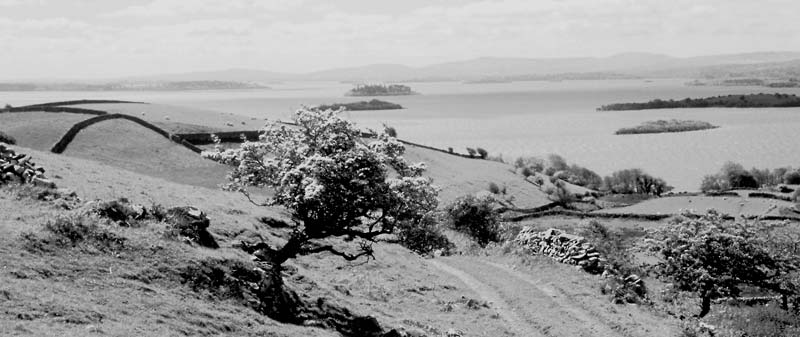
Connemara and Mayo Driving Tour
Map: Connemara & County Mayo Loop
Sights Between Galway and Derry
If you have a car, consider spending a day exploring the wild western Irish fringe known as Connemara and straying into historic County Mayo. Gaze up at the peak of Croagh Patrick, the mountain from which St. Patrick supposedly banished the snakes from Ireland. Pass through the desolate Doo Lough Valley on a road stained with tragic famine history. Bounce on a springy peat bog, and drop in at a Westport pub owned by a member of the Chieftains (a well-known traditional Irish music group). This beautiful area also claims a couple of towns—Cong and Leenane—where classic Irish movies were filmed, as well as the photogenic Kylemore Abbey.
Connemara makes a satisfying day trip by car from Galway. Without a car, you can take a tour from Galway or at least get to Westport by bus. Public transportation in this region is patchy, and some areas are not served at all. Trains connect Galway and Westport to Dublin, but not to each other.
Three Galway-based organizations—Lally Tours, Healy Tours, and Galway Tour Company—run all-day tours of nearby regions (€20-25). Tours of Connemara include the Quiet Man cottage, Kylemore Abbey, Clifden, and a “famine village.” Galway Tour Company takes a slightly different route that includes Cong but omits the coast of Connemara. Tours go most days, heading out about 10:00 and returning at 17:30 (departing from the private coach station on Fairgreen Road in Galway—across from the TI, call to confirm exact itinerary: Lally Tours tel. 091/562-905, www.lallytours.com; Healy Tours tel. 091/770-066, mobile 087/259-0160, www.healytours.ie; Galway Tour Company tel. 091/566-566, www.galwaytourcompany.com). All three companies also offer tours of the Burren and Cliffs of Moher, with discounts if you book two separate tours. Drivers take cash only; to pay with a credit card, book at Galway’s TI.
(See “Connemara & County Mayo Loop” map, here.)
This self-guided loop trip takes a full day and involves five hours of driving, not including stops (almost 200 miles/320 km, using Galway as your base). Start early, so your day will be less rushed. Those wanting to slow down and linger can sleep in Westport. These country roads, punctuated by blind curves and surprise bumps, are shared by trucks, tractors, cyclists, more tractors, and sheep. Drive sanely, and bring rain gear and your sense of humor. This is rural Ireland with all the trimmings.
Bring along a good map (Ordnance Survey atlases are widely sold in Ireland), and before you start, study the loop connecting these points: Galway, Cong, Westport, Louisburgh, Leenane, Kylemore Abbey, Clifden, Roundstone, and back to Galway.
Route Summary: Take N-84 north out of Galway; the road changes names to R-334 in Headford. At Cross, take R-346 into Cong and R-345 back out again. At Neale, go north, putting you back on R-334. Pick up N-84 again as it winds through Ballinrobe to Partry. Take R-330 from Partry to Westport. After lunch in Westport, go west on R-335 through Louisburgh and south through Doo Lough Valley all the way to Leenane. Meet N-59 in Leenane and take it to Kylemore Abbey, continuing to Letterfrack and Connemara National Park. Continue south to Clifden, where you’ll turn off onto R-341. Hug the coast through Roundstone before finding the junction with N-59 near Recess. Follow N-59 back to Galway via Maam Cross and Oughterard.
• From Galway’s Eyre Square, drive north out of town on Prospect Hill Road. Follow the signs at each roundabout in the direction of Castlebar onto N-84. You’ll soon be out of Galway’s suburbs and crossing miles of flat bogland laced with simple rock walls. At Headford, keep straight through town as the road changes names to R-334. At Cross, take R-346 to Cong. You’ll pass the grand, gray gateway of Ashford Castle (on the left) as you approach the town.
Plan to spend an hour in Cong (1.5 hours if you include the Ashford Castle grounds). Cross the small bridge and park in front of the abbey. Drop into the TI across from the abbey entrance for a map (sporadic hours, generally Mon-Sat 10:00-17:00, closed Sun and Oct-April, tel. 094/954-6542). There are no banks or ATMs in Cong (the closest ATM is 10 miles away in Ballinrobe). Public WCs are 50 yards down the street across from the Quiet Man cottage. That’s right, pilgrim, this town is where John Wayne and Maureen O’Hara made the famous John Ford film The Quiet Man in 1951. The gift shop is upstairs; downstairs are the cottage’s modest historical exhibits and film props, only worth it for diehard fans of the Duke (€5, mid-March-Oct daily 10:30-16:00, closed Nov-mid-March, tel. 094/954-6089). Fuel up with a cup of coffee and homemade dessert at the Hungry Monk Café (mid-March-Sept Tue-Sun 10:00-17:00, closed Mon, shorter hours off-season, Wi-Fi, on Abbey Street across from public WCs and a few doors down from TI, tel. 094/954-5842). A solid pub-grub lunch can be had at the Crows Nest Pub (daily 12:00-18:00, Main Street, tel. 094/954-6243).
We’re here for the ruins of Cong Abbey (free and always open). The abbey was built in the early 1100s, when Romanesque was going out of style and Gothic was coming in; you’ll see the mixture of rounded Romanesque and pointy Gothic arch styles in the doorway. The famous Cross of Cong, which held a holy relic of what was supposedly a splinter of the True Cross, was hoisted aloft at the front of processions of Augustinian monks during High Masses in this church. This Irish art treasure is now on display in Dublin’s National Museum. Rory O’Connor, the last Irish high king, died in this abbey in 1198. After O’Connor realized he could never outfight the superior Norman armies, he retreated to Cong and spent his last years here in monastic isolation.
Take a walk through the cloister and down the gravel path behind the abbey. The forested grounds are lush, and the stream water is incredibly clear. Cong’s salmon hatchery contributes to western Ireland’s reputation for great fishing. The monks fished for more than sinners. They built the modest Monks’ Fishing Hut, just over the footbridge, right on the bank so that the river flowed underneath. They lowered a net through the floor and attached a bell to the rope; whenever a fish was netted, the bell would ring.
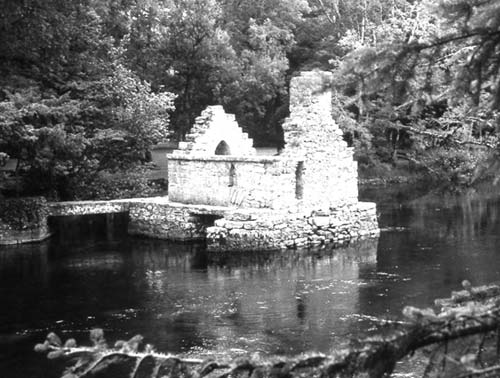
To reach Ashford Castle from the abbey, face the Romanesque/Gothic main entrance and go left around the corner of the abbey, walking 15 minutes down the pleasant forested lane onto the grounds of the castle, which is hidden behind the trees. Garden lovers happily hand over €5 to a kid hired by the castle to patrol the bridge, just so they can stroll the lakeside paradise once owned by the Guinness beer family (entry fee in effect June-Aug, usually free rest of year). The castle evolved from the original, modest Norman keep into this sprawling Victorian complex that rents some of the finest rooms in all of Ireland. Casual gawkers are discouraged inside. Many scenes from The Quiet Man were filmed on the castle grounds. President Reagan stayed here in 1984, and actor Pierce Brosnan chose these gardens for his wedding reception in 2001. Bought for €50 million in 2008, the castle was resold for €20 million in 2013, a steep lesson in the burst bubble of Celtic Tiger property values. As you stroll the grounds, contemplate the fact that “tourism” (the notion of travel solely for enjoyment) didn’t exist until the Victorian Age. Before that time, travel was a chore endured only by armies, refugees, traders, emigrants, and religious pilgrims.
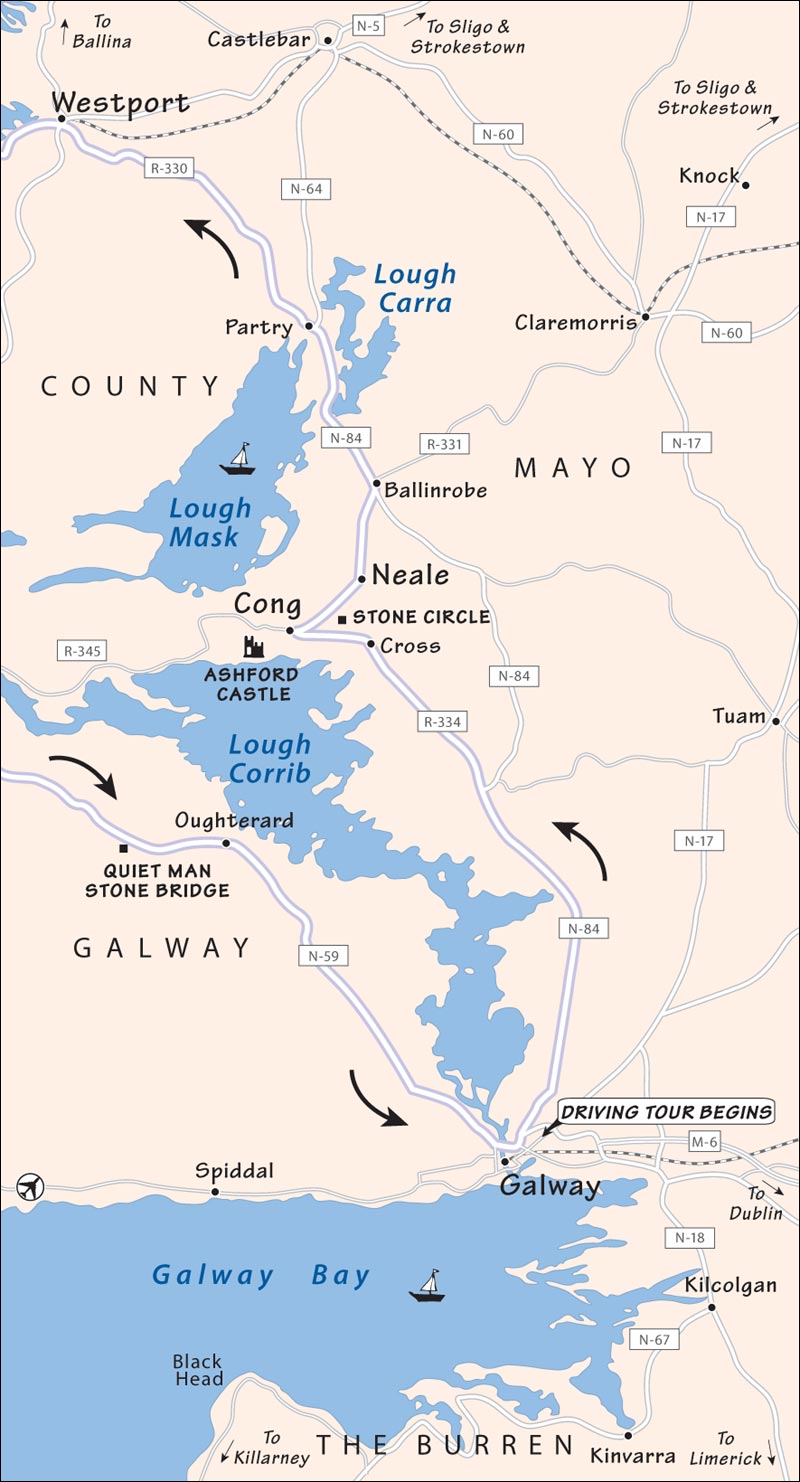
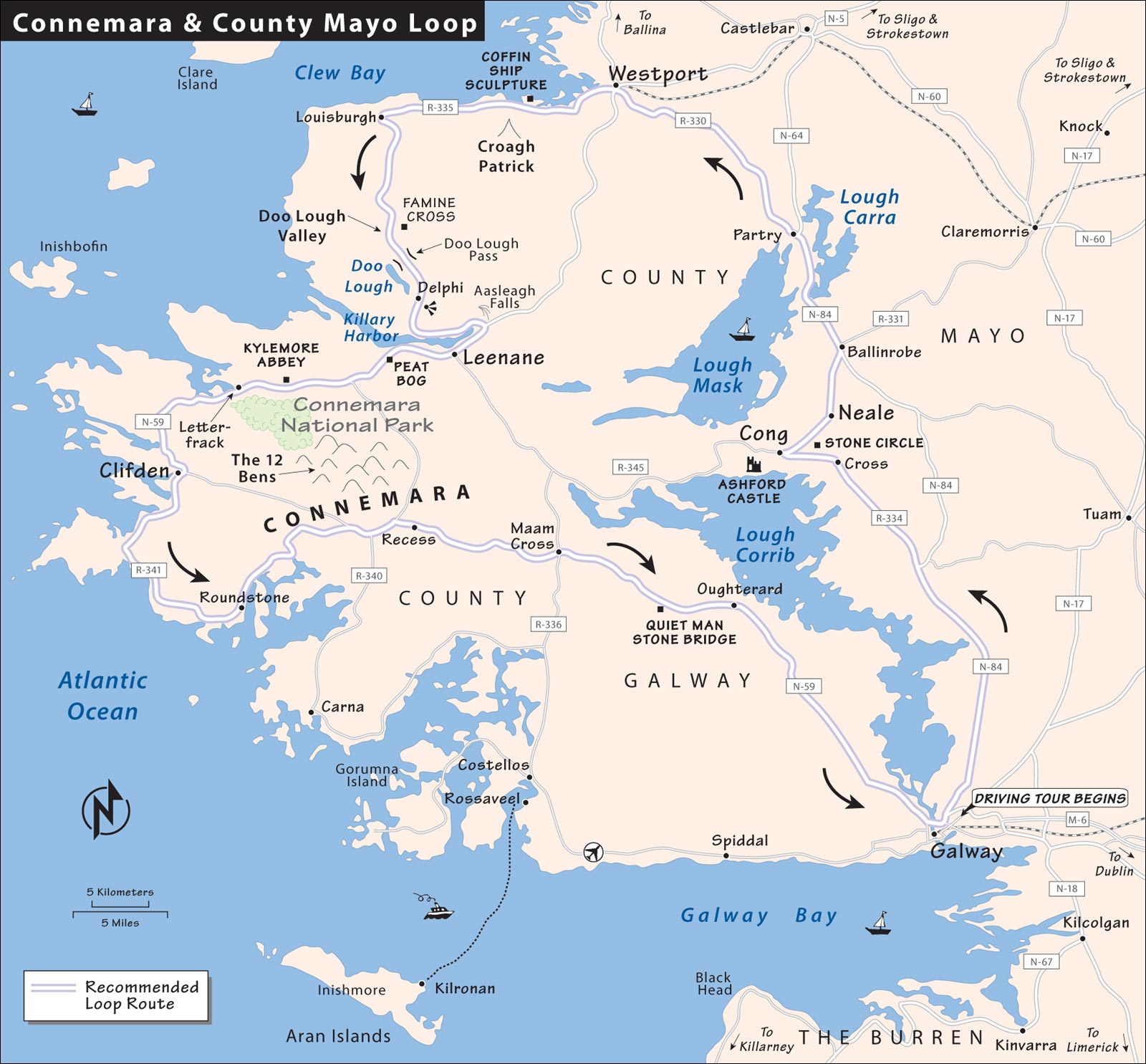
Animal lovers, aviation engineers, and wannabe medieval hunters will thrill to the Ireland School of Falconry, hidden on the Ashford Castle grounds, a 30-minute walk from the TI in Cong (no nearby parking). Head to the back side of the castle (with gardens and fountains facing the lake), then follow Falconry signs 500 yards west, straight up the terraced sidewalk. You’ll first visit the pens housing falcons, owls, and hawks. After a brief Falcon and Owl 101 lesson, you’re led on a “hawk walk” through the forest with an expert handler, sporting on his forearm a Harris hawk—a breed the school’s brochure says is “renowned for its easygoing temperment and unusally sociable nature.” The handler teaches you the surprising intricacies of falconry, and then you have an opportunity to launch and land a bird from your own arm...a unique opportunity you didn’t realize you had on your bucket-list (must reserve ahead, €105 for 1 participant, €90 each for 2, €75 each for 3, €65 each for 4, further discounts for larger groups, no charge for spectactors who don’t launch and land the birds, tel. 094/954-6820, mobile 087/297-6092, www.falconry.ie, info@falconry.ie).
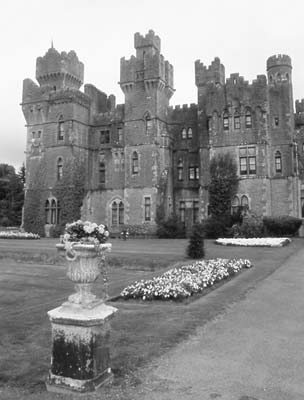
Cong (from conga, Irish for “isthmus”) lies between two large lakes. Departing Cong over the same bridge on which you entered, try to imagine the dry canal that once existed here. Built between 1848 and 1854, this canal was a Great Potato Famine work project that stoked only appetites. The canal, complete with locks, would have linked Lough Mask to the north with Lough Corrib to the south. But the limestone bedrock proved too porous, and the canal wouldn’t hold water.
• Take R-345 out of Cong (left turn opposite the main stone gateway to the grounds of Ashford Castle). Heading north, you’ll pass through the tiny hamlet of...
About 140 years ago, a retired army captain named Boycott was hired to manage the nearby estate of Lord Erne. But the strict captain treated the tenants who worked the lands harshly, so they united to ostracize him by deserting their jobs and isolating the estate. Over time, the agitation worked, and eventually “boycotting” became a popular tactic in labor conflicts.
• At Neale, go north on R-334, then take N-84 from Ballinrobe to Partry. At Partry, turn left off N-84 onto R-330 in the direction of Westport (the easy-to-miss turnoff is just after you pass the thatch-roofed Village Inn). In the countryside a few kilometers to your right is the site of the...
In 1798, a French invasion force supported by locals dealt the British an embarrassing loss here. The surprised British forces were routed, and their rapid retreat is slyly remembered in Irish rebel lore as the “Castlebar races.” Unfortunately for the rebels, this proved to be the last glimmer of hope for Irish victory in that uprising. The Red Coats reorganized and within weeks defeated the small force of 1,300 Frenchmen and the ill-equipped Irish rebels. The captured French soldiers were treated as prisoners of war and shipped back home, while the Irish rebels were executed.
• Continue on R-330 to...
On arrival in Westport, soak up the genteel vibe—lacking in many other Irish towns. Park along the Mall under the trees that line the shallow canal-like river. This is a planned town, built in Georgian style in the late 1700s to support the adjacent estate of Westport House (skip it for better manors at Mount Stewart House and Muckross House). The town once thrived on the linen industry created by local Irish handlooms. But after the Act of Union with Britain in 1801, Westport was unable to compete with the industrialized British linen-makers and fell into decline. The town is still pretty and a good place for a relaxed lunch and some exploration on foot.
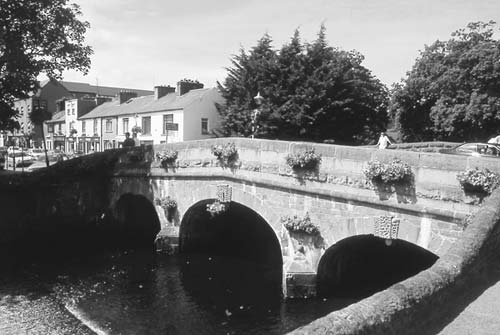
The TI is on Bridge Street (July-Aug Mon-Sat 9:00-17:30, Sun from 10:00; March-June and Sept-Oct Mon-Fri 9:00-17:30, Sat until 16:30, closed Sun; Nov-Feb Mon-Fri 9:00-16:30, Sat 10:00-13:00, closed Sun; tel. 098/25711).
For a short visit, free parking is allowed on the street for two hours; for longer stays, park at your B&B (if sleeping here), or use the pay-and-display lots (€0.70/first hour, €0.30/hour after that, pay at meter and display ticket on dashboard).
The post office is on the North Mall (Mon-Fri 9:00-17:30, Sat 9:00-13:00, closed Sun). Laundry can be dropped off early at Gills and picked up late the same day (€10/load, Mon-Sat 9:00-18:00, closed Sun, James Street, tel. 098/25819). For rainy-day browsing, check out The Bookshop, run by friendly Seamus (Mon-Sat 9:30-18:30, Sun 11:00-18:00, Bridge Street, tel. 098/26816). You gotta love the only shop in Ireland that stocks this guidebook.
Activities in Westport: Clew Bay Bike Hire and Outdoor Adventures, rents a selection of mountain bikes (€15/5 hours, €22.50/24 hours) and electronic assisted bikes (€40/24 hours). They can also set up kayaking or horseback riding outings (daily 9:00-18:00, Distillery Road, tel. 098/24818 or 098/37675, www.clewbayoutdoors.ie).
For a scenic hike or bike ride, consider the 26-mile (42 km) route to Achill Island along the Great Western Greenway (www.greenway.ie). From 1895 to 1937, a narrow-gauge railway operated from Westport to Achill Island. By 2010, the rails had been replaced by a level, paved path, creating an ideal rural route dedicated to bikers and walkers (no vehicles, dogs, or horses allowed). You’ll cross stone bridges, wind through forested sections as well as open bog stretches, and usually have the sea in sight as you hug the flatter coastline. If you want to bike only a section of the route, you can arrange a shuttle-bus pick-up for Newport, Mulranny, or Achill Sound through Clew Bay Bike Hire (listed above).
Sleeping in Westport: For those wanting extra time to explore, Westport is the best place along this route to spend a night. All of the following listings are centrally located. Prices vary quite a bit depending on the season (check for online deals at both hotels).
$$$ Clew Bay Hotel has 54 large, modern rooms decked out in cherrywood furniture (Sb-€60-120, Db-€90-170, Tb-€120-190, prices depend on room size and demand, guest computer, Wi-Fi, free use of adjacent pool and fitness center, James Street, tel. 098/28088, www.clewbayhotel.com, info@clewbayhotel.com).
$$$ Mill Times Hotel has a fresh, woody feel, with 34 comfortable rooms and convenient, free underground parking. On weekends, the nightclub next door gets loud (Sb-€50-95, Db-€90-170, Tb-€135-240, prices depend on demand, Mill Street, tel. 098/29200, www.milltimeshotel.ie, info@milltimeshotel.ie).
$$ Boulevard Guesthouse is the best value in town. Located right on the leafy Mall, it has six large, quiet, tasteful rooms and a cushy lounge with an interesting guest library under the stairs. Sadie and John Moran make you feel welcome (Sb-€45-50, Db-€70-80, Tb-€105, Qb-€120-140, cash only, discount for multiple-night stays, Wi-Fi, parking, South Mall, tel. 098/25138, mobile 087-284-4018, www.boulevard-guesthouse.com, boulevardguesthouse@gmail.com).
$$ Plougastel House B&B, named after Westport’s sister town in Brittany, has six inviting, smartly furnished earth-tone rooms with marble-floored bathrooms (Sb-€40-50, Db-€70-80, cash only, Wi-Fi, Distillery Road, tel. 098/25198, www.plougastel-house.com, info@plougastel-house.com, Sandra Corcoran).
$ Abbeywood House is a hostel in all but name. An economical option hidden uphill behind the Holy Trinity Church, this converted monastery rents seven basic rooms with views of Croagh Patrick (S-€30, D-€60, T-€75, Q-€96, includes continental breakfast, Wi-Fi, closed Sept-Easter except for large groups, Newport Road, tel. 098/25496, mobile 087-241-0641, www.abbeywoodhouse.com, info@abbeywoodhouse.com).
Eating in Westport: Most of your best bets are clustered on Bridge Street. A good choice for dinner is J. J. O’Malleys’ restaurant (€16-26 meals, daily 17:00-22:00, Bridge Street—upstairs, above their pub, tel. 098/27307). Because Mangos Seafood Restaurant serves the town’s best fish in a cozy atmosphere, reservations are a good idea (€15-25 meals, daily 17:45-22:30, July-Aug also serves lunch 12:30-15:00, Bridge Street, tel. 098/24999, mobile 087-665-6368). Madden’s Bistro is on the ground floor of the Clew Bay Hotel and offers contemporary casual dining (daily 12:30-21:00, James Street, tel. 098/28088). For a quick and easy lunch, try O’Cee’s Coffeeshop (€9 cafeteria-style lunches, Mon-Sat 8:30-18:00, Sun 10:00-16:00, Shop Street, tel. 098/27000) or Chilli’s Coffeeshop (Mon-Sat 9:00-18:00, Sun from 10:30; Bridge Street, tel. 098/27007). Irish music fans seek out Matt Molloy’s pub (no food unless you’re on an all-peanut diet, great sessions at 21:30, grab a seat by 20:30 or stand all night, Bridge Street, tel. 098/26655). Matt Molloy isn’t just the owner of the pub—he’s also a flutist for the Chieftains, the group credited with much of the worldwide resurgence of interest in Irish music over the past 50 years. The SuperValu market has picnic fare (daily 8:00-22:00, Shop Street). Dunnes Stores has a similar grocery selection (Mon-Wed 8:30-18:00, Thu-Sat until 19:00, closed Sun).
Westport Connections: If you want to visit Westport but lack wheels, here are your options. You can take a bus to/from Galway (5-7/day, 2-4 hours), Derry (2-4/day, 5.5-6 hours, change in Sligo), or Dublin (6-7/day, 4-6 hours). For details, see www.buseireann.ie. You can also reach Dublin by train (5/day, 3-3.5 hours, www.irishrail.ie).
• Leave Westport heading west on R-335. After about eight kilometers (5 miles), as you’re driving along scenic Clew Bay, you’ll reach a wide spot in the road called Murrisk. Stop here. In the field on your right (opposite Campbell’s Pub) is the...
This bronze ship sculpture is one of the most powerful famine memorials that you’ll see in Ireland. It’s a “coffin ship,” like those of the late 1840s that carried the sick and starving famine survivors across the ocean in hope of a new life. Unfortunately, many of the ships contracted to take the desperate emigrants were barely seaworthy, no longer fit for dependable commerce. The poor were weak from starvation and vulnerable to “famine fever,” which they then spread to others in the putrid, cramped holds of these awful ships. Many who lived through the six- to eight-week journey died shortly after reaching their new country. Pause a moment to look at the silent skeletons swirling around the ship’s masts. Now contemplate the fact that famine still exists in the world. And before judging the lack of effective relief intervention by the British government of that time, consider the rich world’s ability to ignore similar suffering today.
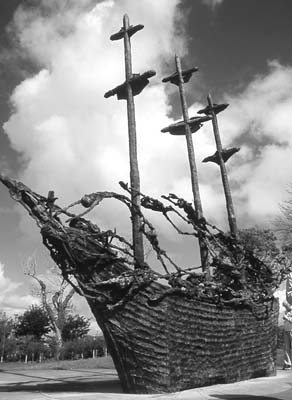
• Across the road from the coffin ship is...
This small mountain rises 2,500 feet above the bay. In the fifth century, St. Patrick is said to have fasted on its summit for the 40 days of Lent. It’s from here that he supposedly rang his bell, driving all the snakes out of Ireland. The snakes never existed, of course, but they represent the pagan beliefs that Patrick’s newly arrived Christianity replaced. Every year on the last Sunday of July, “Reek Sunday” (a “reek” is a mountain peak), 30,000 pilgrims hike three hours up the rocky trail to the summit in honor of St. Patrick. The most penitent attempt the hike barefoot (and often come down on a stretcher). On that Sunday, Mass is celebrated throughout the day in a modest chapel on the top.
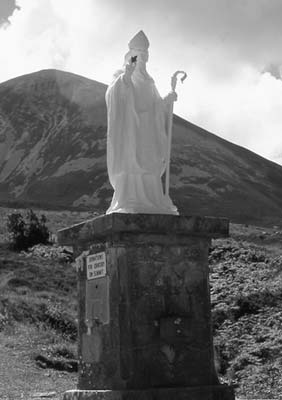
Hikers should allow three hours to reach the top and two hours to get back down (bring plenty of water, sunscreen, and rain gear). There is a primitive WC on the summit, 30 yards below the chapel. The trail is easy to follow, but the upper half of the mountain is a steep slope of loose, shifting scree that can bang or turn exposed ankles. Both times I’ve climbed this, I’ve been glad I wore boots.
A few years ago, valuable gold deposits were discovered within Croagh Patrick. Luckily, public sentiment has kept the sacred mountain free of any commercial mining activity.
• Continue west on R-335.
Stretched out beside you is Clew Bay, peppered with more than 300 humpbacked islands of glacial gravel dumped by retreating glaciers at the end of the last Ice Age. A notorious 16th-century local named Grace O’Malley (dubbed the “Pirate Queen”) once ruled this bay, even earning the grudging respect of Queen Elizabeth I herself with her clever exploits. John Lennon later chose Dorinish Island to found a short-lived hippie commune. He bought it in 1967 for £1,700; after his death Yoko Ono sold it for £30,000 (which she then donated to an Irish orphanage).
• Passing through Louisburgh, you’ll turn south to enter some of the most rugged and desolate country in Ireland.
Signs of human habitation vanish from the bogland, and ghosts begin to appear beside the road. About 13 kilometers (8 miles) south of Louisburgh, stop at the simple gray-stone cross on the left. The lake ahead is Doo Lough (Irish for “Black Lake”). This is the site of one of the saddest famine tales.
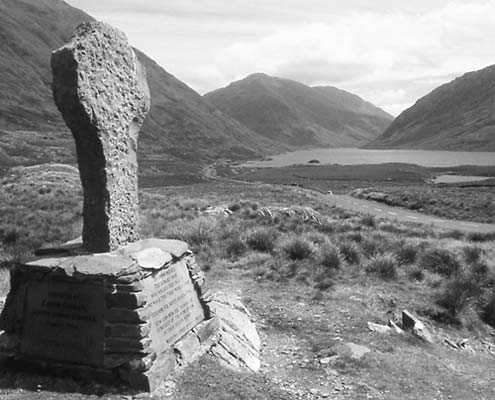
In the early 1800s, County Mayo’s rural folk depended almost exclusively on the potato for food and were the hardest hit when the Great Potato Famine came in 1845. In the winter of 1849, about 600 starving Irish walked 12 miles from Louisburgh to Delphi Lodge, hoping to get food from their landlord, but they were turned away. On the walk back, almost 200 of them died along the side of this road. Today, the road still seems to echo with the despair of those hungry souls, and it inspires an annual walk that commemorates the tragedy. Archbishop Desmond Tutu made the walk in 1991, shortly before South Africa ended its apartheid system.
• Continue south on R-335. You’ll get a fine view of Aasleagh Falls on the left. In late May, the banks below the falls explode with lush, wild, purple rhododendron blossoms. Cross the bridge after the falls, and turn right onto N-59 toward Leenane. You’ll drive along Killary Harbor, an Irish example of a fjord. This long, narrow body of water was carved by an advancing glacier.
This “town” (actually just a crossroads) is a good place for a break. The 1990 movie The Field, starring Limerick-born Richard Harris, was filmed here. Take a glance at the photos of the making of the movie on the wall of Hamilton’s Pub. While you’re there, find the old photo of the British dreadnought battleships that filled Killary Harbor when King Edward VII visited a century ago. Drop into the Leenane Sheep and Wool Centre (on the left as you enter town) to see interesting wool-spinning and weaving demonstrations (€5, April-Oct daily 9:30-18:00, closed Nov-March; no set times for demos, call ahead; tel. 095/42323, www.sheepandwoolcentre.com).
• As you continue west on N-59, notice the rows of blue floats in Killary Harbor. They’re there to mark mussel farms growing on hanging nets in the cold seawater. As you climb out of the fjord valley about 8 kilometers (5 miles) past Leenane, you’ll pass (on the left) some areas that offer good, close looks at a turf cut in a peat bog.
Walk a few yards onto the spongy green carpet. (Watch your step on wet days to avoid squishing into a couple of inches of water.) Find a dry spot and jump up and down to get a feel for it. Have your companion jump; you’ll feel the vibrations 30 feet away.
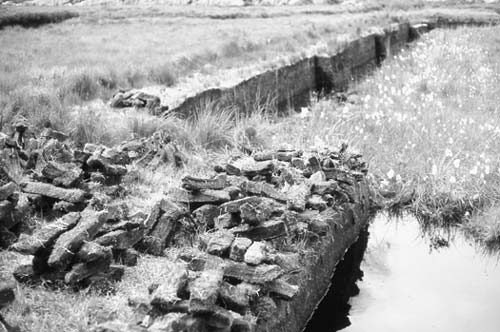
These bogs once covered almost 20 percent of Ireland. As the climate got warmer at the end of the last Ice Age, plants began growing along the sides of the many shallow lakes and ponds. When the plants died in these waterlogged areas, there wasn’t enough oxygen for them to fully decompose. Over the centuries, the moss built up, layer after dead layer, helping to slowly fill in the lakes. During World War I, this sphagnum moss was collected to use in bandages to soak up blood (it absorbs many times its weight in fluids).
It’s this wet, oxygen-starved ecosystem that has preserved ancient artifacts so well, many of which can be seen in Dublin’s National Museum. Even forgotten containers of butter, churned centuries ago and buried to keep cool, have been discovered. But most bizarre are the wrinkled bog mummies that are occasionally unearthed. These human remains (some of them close to 2,000 years old) are so incredibly intact that their eyelashes, hairstyles, and the last meal in their stomachs can be identified. They were likely sacrificial offerings to the pagan gods of Celtic times.
Since these acidic bogs contain few nutrients, unique species of carnivorous plants have adapted to life here by trapping and digesting insects. The tiny pink sundew (less than an inch tall) has delicate spikes glistening with insect-attracting fluid. Take a moment to find a mossy area and look closely at the variety of tiny plants. In summer, you’ll see white tufts of bog cotton growing in marshy areas.
People have been cutting, drying, and burning peat as a fuel source for more than a thousand years. The cutting usually begins in April or May, when drier weather approaches. You’ll probably see stacks of “turf” piled up to dry along recent cuts. Pick up a brick and fondle it. Dried peat is surprisingly light and stiff. In central Ireland, there are even industrial peat cuts that were begun after World War II to fuel power stations. But in the past few decades, bogs have been recognized as a rare habitat, and conservation efforts have been encouraged. These days, the sweet, nostalgic smell of burning peat is becoming increasingly rare.
• Continue west on N-59. The road soon crosses a shallow lake, with a great view of Kylemore Abbey to the right. But don’t stop here—you’ll get a better photo from the parking lot, a few hundred yards ahead. Pull into the lot and take a few minutes to enjoy the view (gate closes at 18:00).
This Neo-Gothic country house was built by the wealthy English businessman Mitchell Henry in the 1860s, after he and his wife had honeymooned in the area. Now they are both buried on the grounds. After World War I, refugee Benedictine nuns from Ypres, Belgium, took it over and ran it as an exclusive girls’ boarding school—which peaked at 200 students—until it closed in 2010. The nuns still live upstairs, but you can visit the half-dozen open rooms downstairs that display the Henry family’s cushy lifestyle (with a 15-minute audiovisual presentation). For me, the best thing about the abbey is the view of it from the lakeshore. But garden enthusiasts will seek out the extensive walled Victorian gardens. From the abbey, the gardens are a one-mile, level walk or quick shuttle bus ride (runs every 15 minutes). Hourly tours of the abbey and gardens are so-so; it’s best just to enjoy the setting.
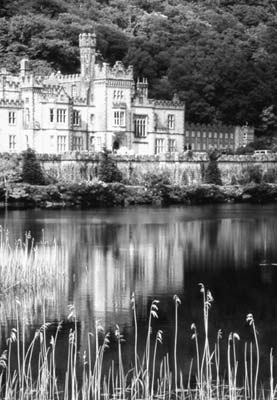
Cost and Hours: Overpriced €13 combo-ticket for abbey and gardens, 10 percent discount if bought online, daily March-Oct 9:00-18:00, shorter hours off-season, WCs in gift shop next to parking lot, cafeteria swims with the chaos of multiple big-bus tour groups, tel. 095/52001, www.kylemoreabbeytourism.ie.
• Heading west from the abbey, you’ll drive less than 8 kilometers (5 miles) to the town of Letterfrack. Pass through the town and go left off N-59 to reach...
This park encompasses almost 5,000 acres of wild bog and mountain scenery. The visitors center displays worthwhile exhibits of local flora and fauna, which are well-explained in the 15-minute Man and the Landscape film that runs every half-hour (free; park open daily year-round; visitors center open daily June-Aug 9:30-18:30, March-May and Sept-Oct 10:00-17:30, closed Nov-Feb, last entry 45 minutes before closing; tel. 095/41054, www.heritageireland.ie). Nature lovers may want to reverse the direction of my driving loop (and skimp on sightseeing time at other stops) in order to enjoy a two-hour walking tour with a park naturalist (July-Aug Wed and Fri at 11:00, departs from visitors center). Call ahead to confirm walking tour schedules, and bring rain gear and hiking shoes.
• If you’re running short on time, you could stay on N-59 the whole way back to Galway. But I prefer to turn south off N-59 in Clifden to enjoy a scenic coastal loop on R-341.
The essence of scenic Connemara—rocky yet seductive—is captured in a neat little 24-mile (38 km) lumpy loop on R-341. The 12 Bens (peaks) of Connemara loom deeper inland. In the foreground, broad shelves of bare bedrock are netted with stone walls, which interlock through the landscape. The ocean slaps the hardscrabble shore. Fishermen cast into their favorite little lakes, and ponies trot in windswept fields. Abandoned, roofless stone cottages stand mute, keeping their stories to themselves. The only settlement on this loop to speak of is Roundstone, a perfect place to stop for a cup of coffee before turning home.
• R-341 links back up with N-59 near Recess. At the junction with N-59, turn right, and follow Galway signs back through Recess, Maam Cross, and Oughterard. Our tour is over.
Travelers continuing on to Northern Ireland (or County Donegal) should get an early start. Allow a day for the drive from Galway to Derry (or Portrush, one hour beyond Derry), with these interesting stops along the way. The town of Knock is right on N-17 as you head north out of Galway, while Strokestown is farther east in County Roscommon. Fill up your tank before crossing into Northern Ireland, since gas is a little cheaper here.
In 1879, locals saw the Virgin Mary, St. Joseph, and St. John appear against the south gable of this tiny town’s church. Word of miraculous healings turned the trickle of pilgrims into a flood and put Knock solidly on the pilgrimage map. Today, you can visit the shrine. At the edge of the site, a small but earnest folk museum shows religious knickknacks, photos of a papal visit, and sturdy slices of traditional life (€4, daily 10:00-18:00, tel. 094/938-8100).
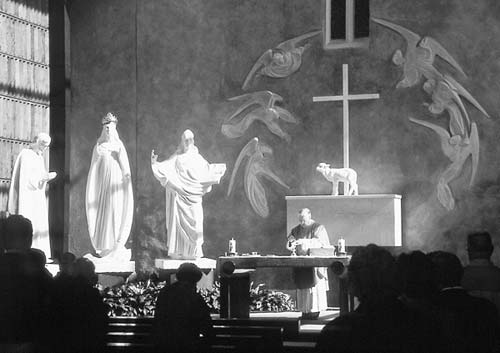
The Great Potato Famine of 1845-1849 was the bleakest period in Irish history—so traumatic that its effects halved the Irish population over the next 50 years and sent desperate, hungry Irish peasants across the globe. It also crystallized Irish-nationalist hatred of British rule. The National Famine Museum fills a mansion on the former estate of the Mahon family in the market town of Strokestown, 60 miles (96.5 km) northeast of Galway.
Cost and Hours: You have several options: museum, house tour, six-acre Georgian walled gardens, or a combination of the three. One sight costs €9, two cost €12, and a combo-ticket for all three is €13.50. Open daily mid-March-Oct 10:30-17:30, Nov-mid-March 10:30-16:00; “Big House” tours (45 minutes) go daily in high season at 12:00, 14:30, and 16:00; tel. 071/963-3013, www.strokestownpark.ie.
Eating: Drivers connecting Westport or Galway to either Dublin or Northern Ireland can stop here en route and grab lunch in the museum café.
Visiting Stokestown Park: In the museum, thoughtful exhibits explain how three million Irish peasants survived on a surprisingly nutritious pre-famine diet of buttermilk and potatoes (12 pounds per day per average male laborer...potatoes are 80 percent water). When a fungus destroyed the potato crop, it sparked the Great Potato Famine, and as many as a million Irish people died of starvation.
Major Mahon, the ill-fated landlord here during the famine, found it cheaper to fill three “coffin ships” bound for America with his evicted, starving tenants than pay the taxes for their upkeep in the local workhouse. When almost half died at sea of “famine fever,” he was assassinated.
The tours of the musty “Big House” provide insights into the gulf that divided the Protestant ascendancy and their Catholic house staff. Afterward, find the servants’ tunnel—connecting the kitchen to the stable—built to avoid cluttering the Mahon family’s views with unsightly common laborers.